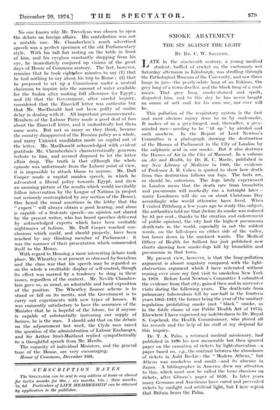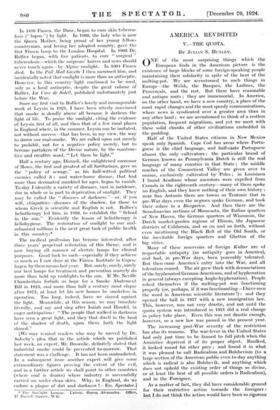SMOKE ABATEMENT
THE SIN AGAINST THE LIGHT
BY DR. C. W. SALEEBY.
LATE in the nineteenth century, a young medical student, baffled of cricket on the customary wet Saturday afternoon in Edinburgh, was strolling through the Pathological Museum of the University, and saw three lungs in jars—the pearly-white lung of an Eskimo, the grey lung of a town-dweller, and the black lung of a coal. miner. That grey lung, smoke-stained and spoilt, disgusted him, and to this day he has never bought an ounce of soft coal for his own use, nor ever will he.
This pollution of the respiratory system is the first and most obvious injury done to us by coal-smoke.
It makes of us a grey-lunged, and, thereafter, a grey- minded race—needing to be "lit up" by alcohol and such mockers. In the Report of Lord Newton's Committee is a photograph showing the destruction of the Houses of Parliament in the City of London by the sulphuric acid in our smoke. But it also destroys the Houses of Air in the City of Manson]. In a volume on Air and Health, by Dr. R. C. Macfie, published in my New Library of Medicine in 1909, the evidence of Professor J. B. Cohen is quoted to show how death from this destruction follows our fogs. The facts are, or should be, notorious. The fogs lately experienced in London mean that the death rate from bronchitis and pneumonia will markedly rise a fortnight later— many Londoners will die on or about Christmas Day accordingly who would otherwise have lived. When I visited Pittsburg a few years ago to study this subject, the authorities told me that (before its smoke was reduced by 85 per cent., thanks to the creation and enforcement - of public opinion), the city had the highest pneumonia .death-rate in the world, especially in not the coldest wards, on the hill-slopes on either side of the valley, . but lower down in the smokiest wards. The Medical Officer of Health for Salford has just published new charts showing how smoke-fogs kill by bronchitis and pneumonia in that town.
My present view, however, is that the lung-pollution 'argument is almost nugatory compared with the light- -obstruction argument which I have reiterated without ceasing ever since my first visit to smokeless New York in 1919. Before Lord Newton's Committee I submitted the evidence from that city, gained then and in successive visits during the following years. The death-rate from pulmonary tuberculosis fell by one-half in the fourteen years 1905-1919, the former being the year of the sanitary .regulation prohibiting smoke (not " black " smoke, as in the futile clause of our Public Health Act of. 1875). Elsewhere I have expressed my indebtedness to Dr. Royal S. Copeland, the Health Commissioner, who placed all his records and the help of his staff at my disposal for this inquiry.
Dr. T. A. Palm, a returned medical missionary, had published in 1890 his now memorable but then ignored paper on the causation of rickets by light-starvation--a paper based on, e.g., the contrast between the abundance -of rickets in Auld Reekie—the "Modern Athens," but Athens was smokeless and sunlit—and its absence in Japan. A bibliographer in America drew my attention to this, which must now be called the locus classicus on rickets, after Glisson's paper of 1650. In later years many Germans and Americans have cured and prevented rickets by sunlight and artificial light, but I here repeat that Britain bears the Palm. In 1893 Finsen, the Dane, began to cure skin tubercu- losis (" lupus ") by light. In 1900, the lady who is now the Queen Mother, being proud of her young fellow- countryman, and loving her adopted country, gave the first Finsen lamp to the London Hospital. In 1903 Dr. Rollier began, with five patients, to cure " surgical " tuberculosis—which the surgeons' knives and Saws Should never touch again—by Alpine sunlight. In 1904 Finsen died. In the Pall Mall Gazette I then mourned him, and incidentally noted that sunlight is more than an antiseptic. However, in this country light continued to be used, only as a local antiseptic, despite the great volume of Rollier, La Cure de Soleil, published unfortunately just before the War.
Since my first visit to Rollier's lovely and incomparable work at Leysin in 1921, I have been utterly convinced that smoke is deadly above all because it darkens the light of life. To praise the sunlight, citing the evidence of Leysin first of all, and then that of a few rural places in England where, in the summer, Leysin can be imitated, not without success—that has been, in my view, the way to damn our coal-smoke. We are called upon not merely to prohibit, not for a negative policy merely, but to become partakers of the Divine nature, by the construc- tive and creative word, "Let there be light."
Half a century ago, Disraeli, the enlightened successor of Moses, the first and greatest of all Sanitarians, gave us the "policy of sewage," as his half-witted political enemies called it : and water-borne disease, that had more than decimated mankind for ages, began to vanish. To-day I identify a variety of diseases, vast in incidence, due in whole or in part to deprivation of sunlight. They may be called the "diseases of darkness "—or, if you will, skiapathies—diseases of the shadow; for those to whom Greek is scientific and English is not. Rollier's heliotherapy led him, in 1910, to establish the "School in the sun." Evidently the lesson of heliotherapy is heliohygiene. The restoration of sunlight to our mat- urbanized millions is the next great task of public health in this country.* The medical profession has become interested, after three years' perpetual reiteration of this theme, and is now buying all manner of electric lamps for clinical purposes. Good luck to such—especially if they achieve as much as I saw done at the Finsen Institute in Copen- hagen by these means last year. But, surely, surely, surely our best lamps for treatment and prevention scarcely do more than hold up rushlights to the sun. If Mr. Neville Chamberlain forbids us hope for a Smoke Abatement Bill in 1925, and more than half a century must elapse after 1875, at least let his new houses be smokeless in operation. Too long, indeed, have we sinned against the light. Meanwhile, at this season, we may translate literally, and say and sing after Isaiah and Handel, in eager anticipation : "The people that walked in darkness have seen a great light, and they that dwell in the land of the shadow of death, upon them hath the light shined."
[We may remind readers who may be moved by Dr.
Saleeby's plea that in the article - whieh we published last week, an expert, Mr. Brownlie, definitely stated that industrial smoke could be prevented to-morrow. That statement was a challenge. It has not been contradicted. In a subsequent issue another expert will, give some extraordinary figures proving the extent of the evil, and in a further article we shall point to other countries (where coal is dearer) where industry is successfully carried on under clean skies. Why, in England, do we endure a plague of dirt and darkness ?—ED. Spectator.]
* The Sunlight League. ratron. Queen Alexandra. Office,
37 Russell Square, W.O. _ • -











































 Previous page
Previous page